With some exceptions, watch brands are part of a few powerful groups, such as Richemont, Swatch, and LVMH. Richemont is especially known for their Haute Horlogerie brands – notably Vacheron Constantin and Cartier. But the group holds a precious little gem, with a great variety of models at a reasonable price point, making them an affordable luxury, as their own advertising claims. Let us introduce you to Baume & Mercier.
How Baume et Mercier Began

The story of Baume & Mercier company began, as many other watch brands, with a duo – in this case, the Baume brothers, Pierre Joseph Célestin and Louis Victor. They created their company “Frères Baume, la Famille Louis Joseph” in 1830 in the Swiss village of Les Bois and were joined a few years later by their other two brothers, Charles Auguste Félicien and Joseph Eugène.
The family already had a long tradition in watchmaking. Originally from the French Jura region, they left Baume-les-Dames (baume means “cavern under rocks”, a typical landscape feature in Jura) for Montagne des Bois, in 1542.

The family company helped the professional development of the young watchmaking apprentices in Les Bois; finishings, engravings and movement decoration were made in Geneva, as well as the gold watch cases. The silver cases were made near Les Bois with the coveted “English Style” finishing.

At the time, most pocket watches were thick and bulky, which was cumbersome and heavy for gentlemen to take their watch from their vest pocket to check the time. To counter this problem, in 1760 Jean Antoine Lépine created a slimmer movement for pocket watches, and in 1840 the Baume brothers adopted the Lépine concept.

Not long after the company’s inception, the brothers realized the potential of their products in the international market and set up shop in London. Célestin moved to London in 1847 and, in 1851, created the “Baume Brothers” in Clerkenwell, moving later to Hatton Garden, 21. Afterwards, they expanded quickly over the British Empire and even to the Far East.

In the early 1880s, Alcide Eugène, Louis Victor’s son, was managing the Swiss branch, and his brother Arthur Joseph, the London division. Thanks to their motto – “Accept only perfection” – three Baume products were classified among the seven most precise watches tested by the observatories (Kew and Teddington) in 1885, a precision that had to be reached in order for a company to become a supplier for the Royal Navy. They received another prize for their split-second chronographs in 1887.
Baume Meets Mercier

In 1910, the third son of Alcide Eugène, William Adolphe Baume, started to work at his father’s company. Two years later, he met Paul Mercier, and the duo became a partnership in November 1918, creating the new “Baume & Mercier”. Baume took care of production and Mercier was in charge of the commercial aspects of the new enterprise. However, the brand was registered only in 1920.
Paul Mercier’s story wouldn’t be out of place in a Russian novel. In fact, his father was a Russian officer named Tchereditchenko, who met the young Miss Mercier – a seamstress at Maison Worth – in Paris in 1867. They married and moved to Russia, eventually having seven kids. One day, while hunting wolves, Tchereditchenko’s sled fell in a frozen lake and he died.
His widow returned to Paris with some of their kids, Paul among them. He started to work at 10 and studied languages in his spare time: he managed to be fluent in seven idioms. He moved to London where he worked as a salesman for a jeweler, Haas; after a while, he met William Baume. Adopting the Swiss citizenship with his mother’s maiden name, he became Paul Mercier.

In 1921, Baume et Mercier received the coveted Poinçon de Genève, the Geneva Seal, a certification considered a high accolade in the watch industry.
New Command
During the 1930s, however, both Baume and Mercier left the company, which was then managed by Constantin de Gorski; after the Second World War, Baume & Mercier was run by Marc Beuchat and René Juillerat.

Their first post-war model of success was the feminine Marquise, a small, elegant watch with an integrated bracelet, a design that was copied by many watch brands.
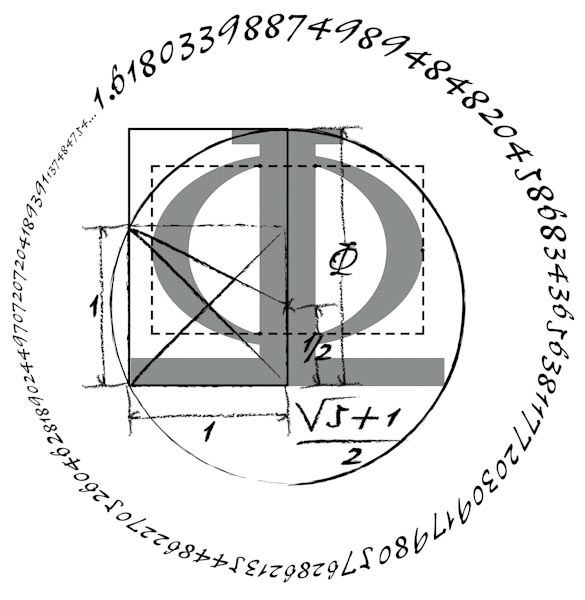
In 1964, the company adopted as a symbol the Greek letter Phi, which has appeared in every dial since then. The letter represents the “Golden Ratio”, evoking a harmonious proportion that is present all over nature.
The Quartz Crisis

The 70’s were a critical decade for the Swiss watch industry: quartz watches – mainly made in Japan, like the Seiko Quartz Astron pictured above – largely replaced mechanical, traditional Swiss models, making the number of employees in the Swiss companies fall from 90,000 in 1970 to 28,000 in 1988.
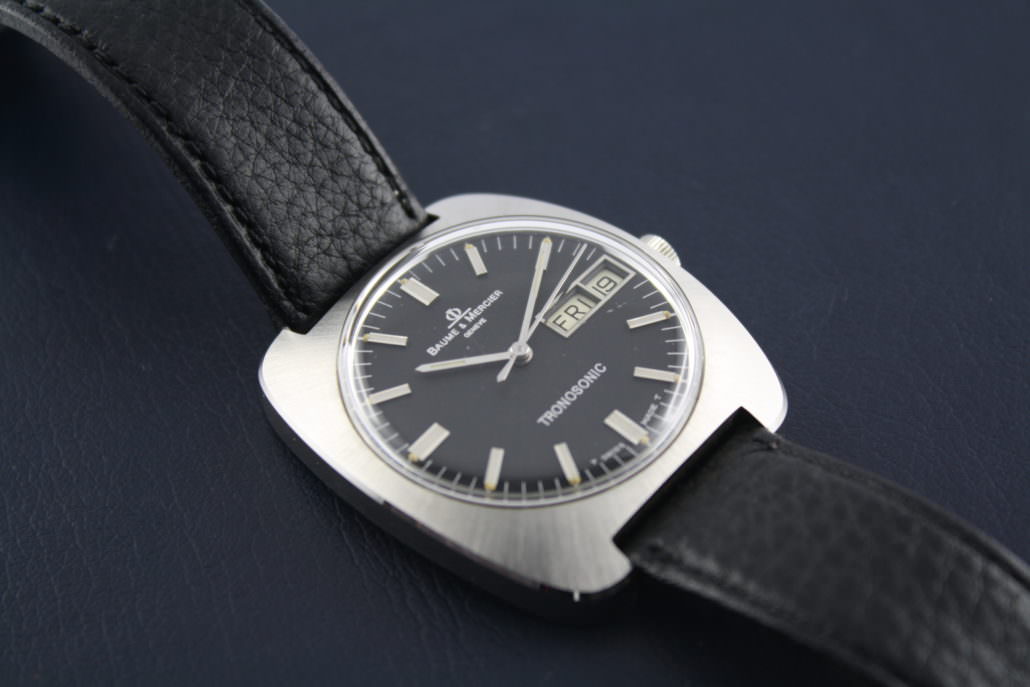
Baume & Mercier would not pass immune through the quartz movement craze and, in 1971, the company created the Tronosonic, an electric watch. They used ESA tuning fork movements, such as the model above: with day and date windows at 3 o’clock, it ran on the ESA 9164. A white gold version of this watch sells today for circa $3,500 on sites such as chrono24.com.
Notable Watch Models
RIVIERA


From 1973, the Riviera suggested the elegance of the French summer resort with its dodecagonal bezel. The line was enriched in 1981 with a diving version with world time, in 1987 with a complete calendar model and, in 1993, celebrating the 20th anniversary of the Riviera, a chronograph.
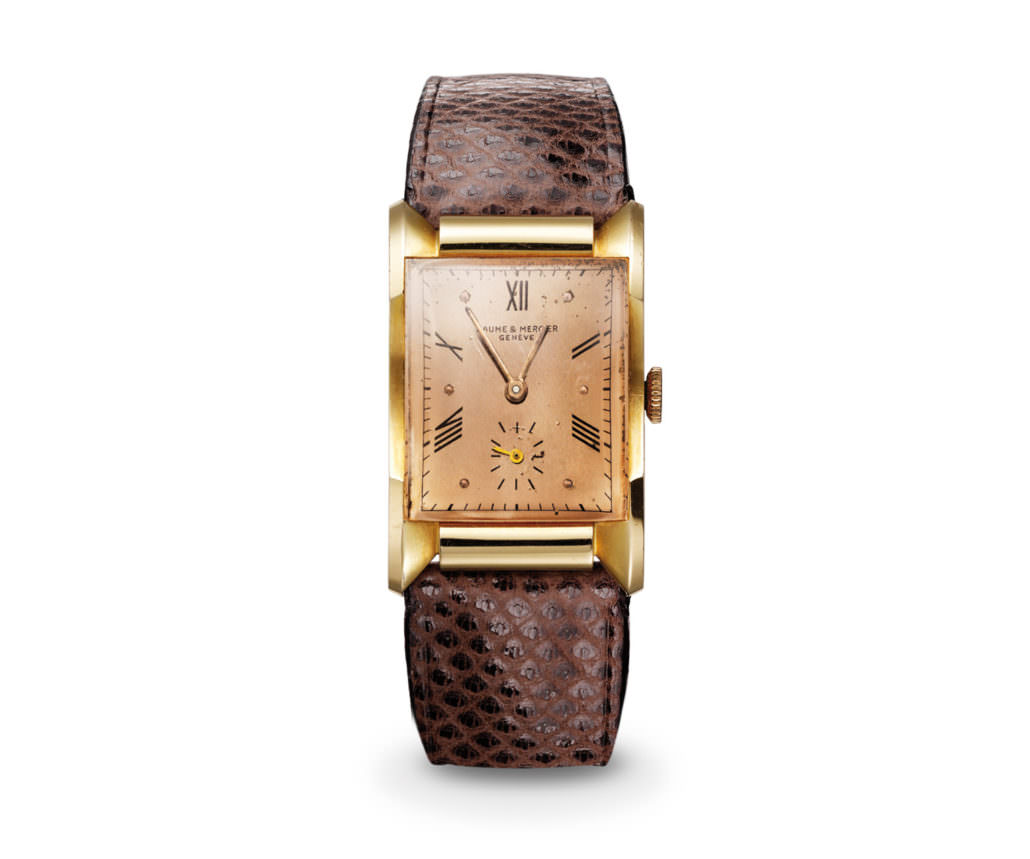
In 1988, the Richemont group bought Baume & Mercier assets, giving the brand new horizons to explore. The Hampton design – launched in 1994, inspired by a 1960 model – expanded into a full collection, with an ergonomic fit to the curvature of the wrist.
Presently, Baume & Mercier offers watches for gentlemen with prices that go from $990 for a steel Classima to $22,900 for a red gold Clifton with perpetual calendar. So, what are the brands’ most interesting models?
HAMPTON

The Hamptons are, arguably, one of the most elegant summer retreats in America, with celebrities such as Paris Hilton, Steven Spielberg, Ralph Lauren and Calvin Klein included among the owners of weekend houses there.

Baume & Mercier Hampton watches tries to convey the same elegance in their sleek and curved lines. My own favorite Hampton model is the Dual Time, no longer in production but that may be found in auctions or on eBay, for instance. It is a quartz watch with two movements moving two independent dials, one showing home time and the other the local time. It is my travel watch par excellence.
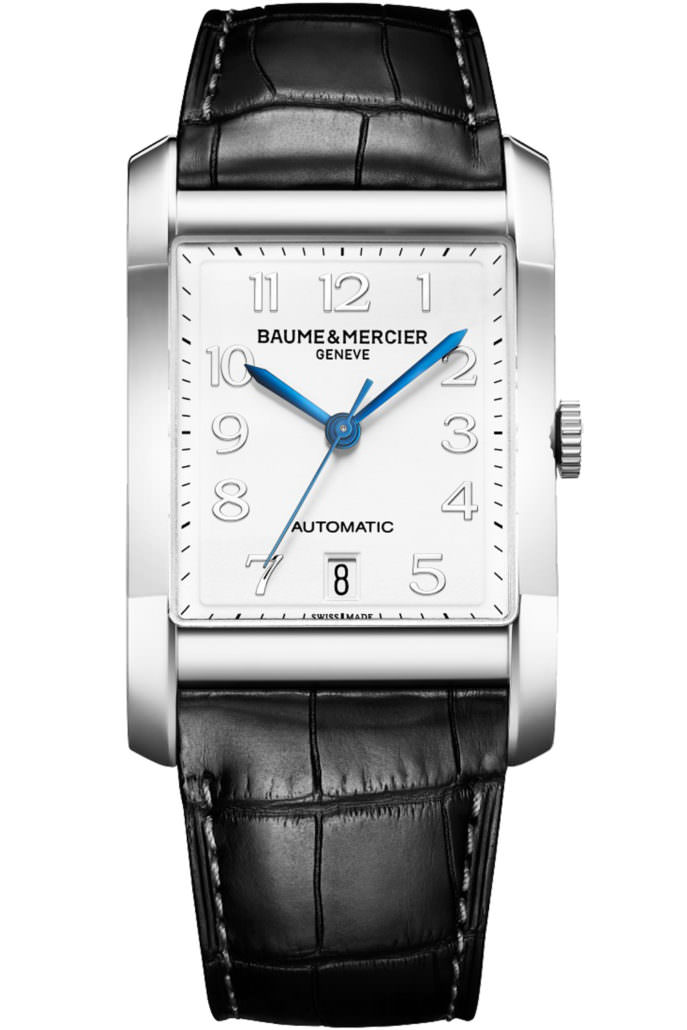
In the current line, I like the reference 10155, an automatic watch with the Golden Ratio proportion in the case design, blued steel hands, off-white dial and a date window at 6 o’clock. A sapphire crystal visor on the back shows the oscillating weight in action, and the black alligator strap with folding buckle makes this Hampton an excellent daily watch for work.
CLASSIMA

Classima may be considered Baume & Mercier’s entry-level collection, aimed at the young professional looking for a classic watch made by a good brand and with a reasonable price point. The cases are round with a discrete size (around 39 or 40 mm diameter) and with leather straps – which I prefer at work – or metal bracelets. Most have silver-colored dials, but the blue- or the gray-colored versions (such as the one above) make a more powerful statement. The case back has ample space to engrave a message, initials or a date, making this line a great gift for a graduate.

There is also a Classima chronograph, a more sportive automatic watch with date window at 3 o’clock, an elegant opaline dial and blued steel hands, and a sapphire crystal back.
CLIFTON

With a more sporty look, the Clifton Club is a new line of Baume & Mercier watches with some color and prices that go from $1,950 to $2,250, with automatic movements.

But if you want to splurge a little, go for the Clifton Club Shelby Cobra, a great tribute to the famous Shelby Cobra, a limited edition of 196 pieces (hinting at the top speed of the Cobra Daytona Coupe, 196 mph), with a steel case of 44mm and a beautiful dial in blue and white, also evoking the famous car. There is a different version here.

The blue leather strap has a carbon-like design, and the second’s hand of the chronograph is red with the cobra at one end.
CAPELAND

If you are a fan of the 1940s watch design, you can’t miss this model: the Capeland Chronograph (ref. 10006) is both sporty and elegant. The steel case has a reasonable-sized diameter (44mm), but the charm is its off-white dial with flyback chronograph. It means you can time a small series of events, such as two racing cars passing by a reference point, one after the other, without having to reset the chronograph hand. Also, it has a rare telemeter, a function that enables you to know the distance between you and a storm: you press the chronograph when you have a visual indication (the lightning) and stops it when you hear the thunder that accompanies the bolt. The chronograph hand will point to the distance in kilometers.
Affordable Luxury
To sum it up, I could say that Baume & Mercier watches are good options for their price range, even though they are not alone in the value price scale (Longines, for one, also offers good quality and design for a smaller price). Also, they are not a manufacturer, that is, they don’t produce their movements, and the brand has very few wow factor watches, one exception being the Clifton Club Shelby Cobra shown above.
However, if your main concern is to have a watch of a good company, with a nice design and quality components, that may be used every day and project a good and reliable image, then Baume & Mercier’s rich history may be your “affordable luxury”.
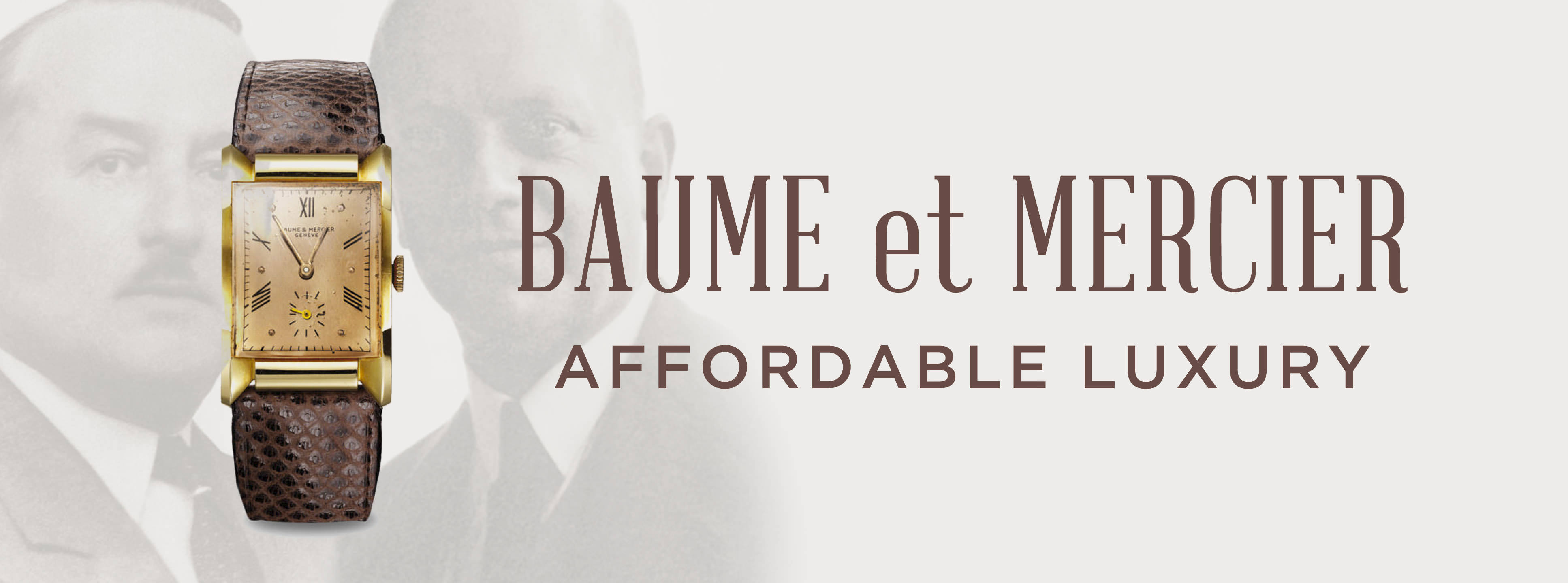
Good article and excellent recommendations! Like most watch aficionados, I admire the big three — Patek Philippe, Vacheron Constantin and Aduemars Piguet. I would, however, prefer to spend the equivalent amount of money on a car rather than a watch. Baume et Mercier watches are excellent values. The 18k rose gold Classima automatic is all the dress watch anyone really needs. The gold case automatic Longines are also excellent values in the same price range.
Keep up the good work!
$11,000 USD watch is not affordable luxury, anyhow I know this is sponsored.
I agree. Of course ‘affordable’ is a relative term, but there are a good many quality mechanical watches to be found that are accurate and elegant. One doesn’t need to push into 4 figures for that.
As for the sponsorship; I don’t blame anyone for trying to make a dollar or get product in exchange for promotion, but the lack of disclosure on this site is problematic.
Great article and suggestions. The B&M Classima automatics in 18k gold cases are great values. Yes, I’d love a Patek, Vacheron or AP on my wrist, but I’d rather have a nice car in my garage for what they are going for these days. Longines and Tissot automatics are great values at MSRP and downright steals at street prices.
Keep up the good work!
I’m not usually a fan of rectangular watches, but “The Hampton ref. 10155” is just gorgeous with its blue hands on a white dial. Love it!